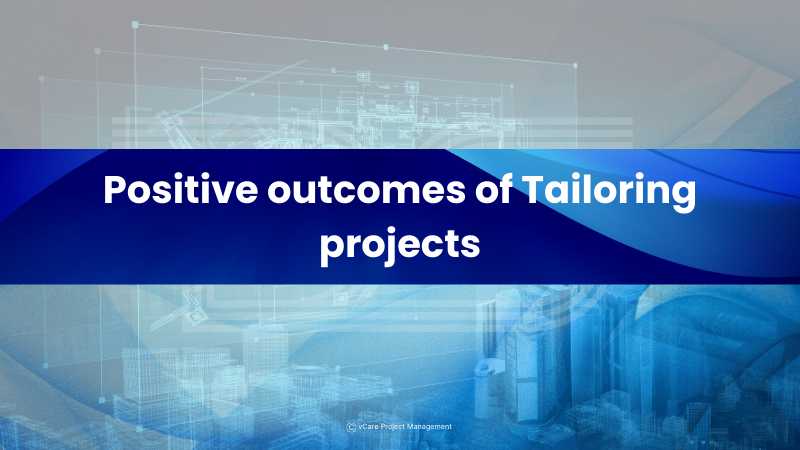
by DharamCW | Jul 11, 2024 | Leadership in Project Management, Project Management, Project-Program-Portfolio Management Knowledge
Positive outcomes of Tailoring projects | PMBOK 7TH Edition
Adapting to the environment’s unique objectives, stakeholders, and complexity contributes to project success. Tailoring is the deliberate adaptation of approach, governance, and processes to make them more suitable for the given environment and the work.
Tailoring projects can lead to the following positive outcomes:
– Increased innovation, efficiency, and productivity
– Lessons learned so that improvements from a specific delivery approach can be shared and applied to the next round of work or future projects
– Further improvement of an organization’s methodology with new practices, methods, and artifacts
– Discovery of improved outcomes, processes, or methods through experimentation
– Effective integration within multidisciplinary project teams of methods and practices used to deliver project results
– Increased adaptability for the organization in the long term
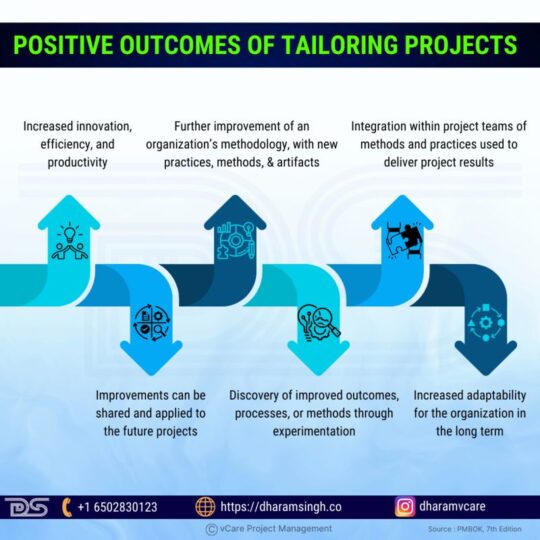
Tailoring projects enhances efficiency, innovation, and long-term adaptability! Learn how PMBOK 7th Edition supports tailored project strategies.
Explore our useful PMP Study Materials:
vCare PMP Exam Simulator – 1 Year Access: https://bit.ly/41BFc6A
PMBOK Guide | 7th Edition: http://bit.ly/2Z2Zn1b
🚀 Elevate Your Project Management Career:
– Register for my upcoming PMI Certification Success Story Webinars: https://bit.ly/3WwX1D7 / https://bit.ly/3xHeZZH
– Book an obligation-free consultation session on Project management Career, training, and certifications: http://talktodharam.com
– Discover training offers and certification discounts: https://bit.ly/3jWVepD
– Stay updated with our Q&A series and certification success stories by subscribing to the vCare Project Management YouTube channel at https://bit.ly/2YF0wJl
– Follow my podcasts and interviews with Project Management Experts on YouTube at https://bit.ly/2NDY8wd
#ProjectManagement #PMBOK7 #TailoringProjects #AdaptationStrategies #StakeholderManagement #ProjectSuccess #EfficiencyImprovement #InnovationInProjects #LessonsLearned #PMP #MethodologyImprovement #ProjectLeadership #ContinuousImprovement #vCareProjectManagement
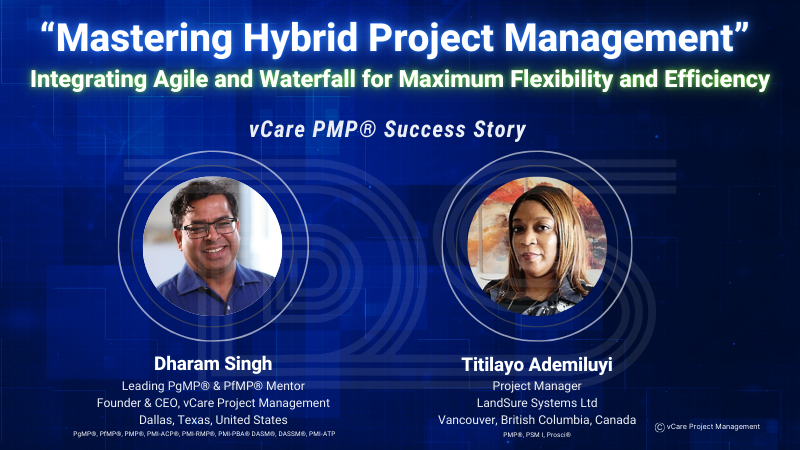
by DharamCW | Jun 11, 2024 | Professional Development Webinars
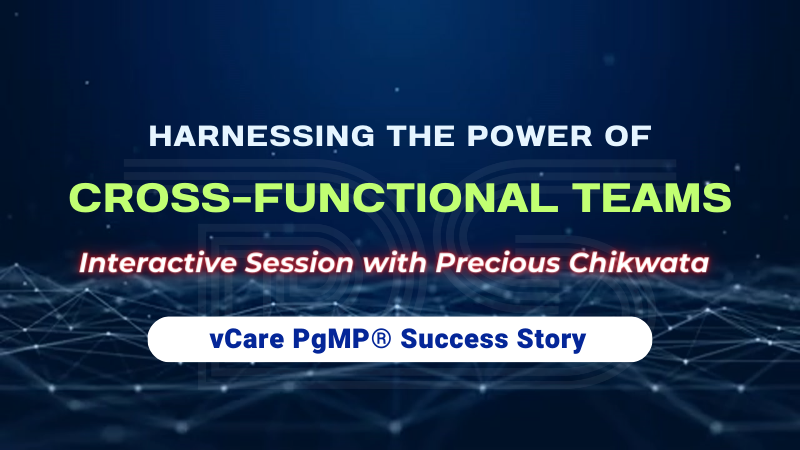
by admin | Mar 11, 2024 | Program Management
Join Precious Chikwata PMP®,MBA,PgMP®PgCert Cybersecurity and me for an insightful Q&A session as we explore the dynamics of cross-functional teams. Dive deep into the reality beyond the statistic that “75% of cross-functional teams are dysfunctional.” As seasoned Project/Program Managers, let’s discuss this figure, exchange experiences, and examine the essence of effective teamwork.
In this episode, we’ll also discuss how to navigate crises by building resilient networks of teams and the pivotal skills required for managing cross-functional teams and stakeholder expectations.
🔑 Highlights of the session include:
– Precious Chikwata’s personal PgMP journey
– Strategies to construct resilient teams during crises
– Debunking the myths of cross-functional team dysfunction
– Navigating stakeholder expectations within complex team structures
– Tactics to dismantle silos and enhance inter-team collaboration
– Resolving tough conflicts and extracting valuable lessons
– Essential skills for leading cross-functional teams as a Program Manager
– Managing expectations when program deadlines are at risk
– Utilizing PDUs effectively
– Tips for passing the exam
– Insights on rebounding from market challenges to secure your next role
Unlock these insights and enrich your knowledge by watching the full episode now: https://youtu.be/D3rzic6MbSg
🚀 Elevate Your Project Management Career:
– Register for my upcoming PgMP/PfMP Success Story Webinar: https://bit.ly/3ON2Ibl
– Book an obligation-free consultation session on Project management Career, training, and certifications: http://talktodharam.com
– Discover training offers and certification discounts: https://bit.ly/3jWVepD
– Stay updated with our Q&A series and certification success stories by subscribing to the vCare Project Management YouTube channel at https://bit.ly/2YF0wJl
– Follow my podcasts and interviews with Project Management Experts on YouTube at https://bit.ly/2NDY8wd
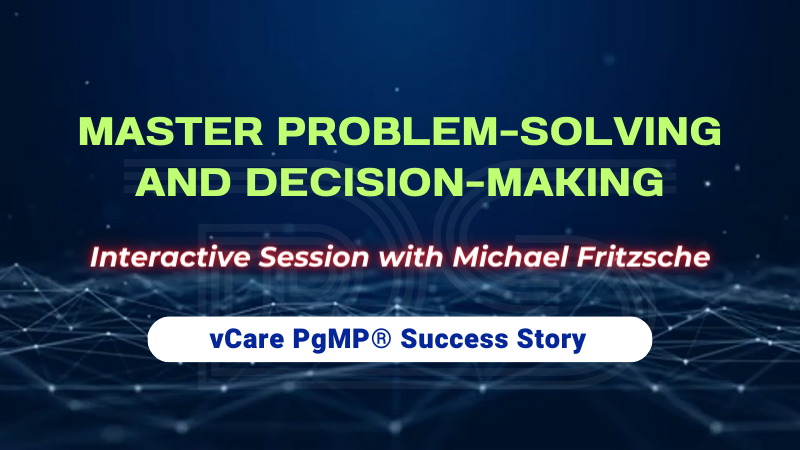
by admin | Mar 9, 2024 | Professional Development Webinars
Join me for an exclusive webinar where Michael Fritzsche, a distinguished Project, Program, and Portfolio Management professional in the automation industry from Rheinböllen, Rhineland-Palatinate, Germany, will share his journey and experiences, offering attendees a unique perspective on overcoming challenges and leading strategic projects.
Key topics to be covered include:
– Equipping Senior Managers for Strategic Decision-Making.
– The Dynamics of Human Judgment vs. Algorithms in Decision-Making.
– Best Practices for Building Stakeholder Trust and Credibility.
– Effective Use of Deadlines to Boost Productivity.
🔗 Reserve your spot now: https://bit.ly/3ON2Ibl
Session Date: 21st March 2024
Session Time: 09:30 AM – 10:30 AM (PDT) / 10:30 AM – 11:30 AM (MDT) / 11:30 – 12:30 PM (CDT) / 12:30 PM – 01:30 PM (EDT) / 01:30 PM – 02:30 PM (BRT) / 04:30 PM – 05:30 PM (GMT) / 05:30 PM – 06:30 PM (CET) / 07:30 PM – 08:30 PM (AST) / 08:30 PM – 09:30 PM (GST) / 10:00 PM – 11:30 PM (IST)
🚀 Elevate Your Project Management Career:
– Book an obligation-free consultation session on Project management Career, training, and certifications: http://talktodharam.com
– Discover training offers and certification discounts: https://bit.ly/3jWVepD
– Stay updated with our Q&A series and certification success stories by subscribing to the vCare Project Management YouTube channel at https://bit.ly/2YF0wJl
– Follow my podcasts and interviews with Project Management Experts on YouTube at https://bit.ly/2NDY8wd
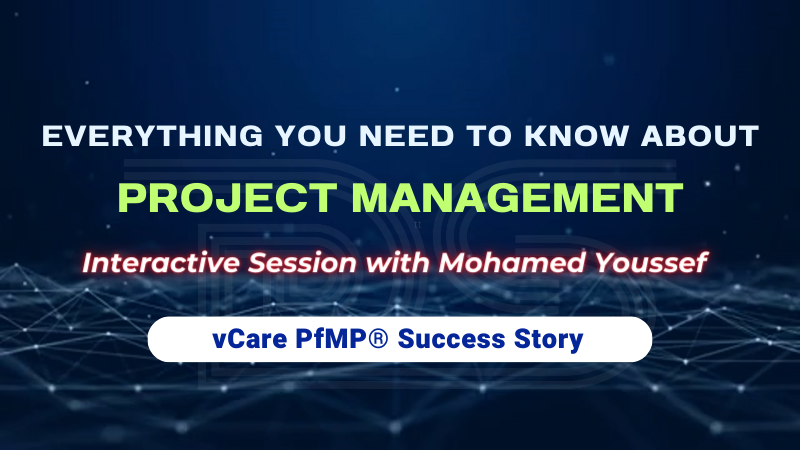
by DharamCW | Jan 11, 2024 | Professional Development Webinars
Free Webinar: Everything You Need to Know About Project Management
Mark your calendars for Jan 18, 2024! I am thrilled to host an insightful session with Mohamed Youssef ,B.Eng,MBA , PfMP®,PgMP®, PMP®, RMP®, CCCM, MEP Operation Manager at Electro Mechanical Engineering Co., Doha, Qatar and a recent PfMP® certificant, bringing over two decades of expertise to the table. It’s a unique opportunity to gain valuable career insights and understand the nuances of the PfMP® certification.
Gain 1 PDU and enrich your project management toolkit as we explore:
✅ Showcasing your organizational contributions through meticulous project tracking.
✅ Mastering contingencies with best practices in project management.
✅ Steering stakeholder expectations alongside time plan adjustments.
✅ The art of inspirational leadership for team growth.
✅ The power of active listening in bolstering team dynamics for project triumph.
This session is crafted for project management professionals poised to lead with agility and strategic foresight. Embrace this chance to refine your leadership understanding and drive project excellence.
🔗 Don’t miss out; reserve your spot now: https://bit.ly/4aLdJmP
Session Time: 08:30 AM – 09:30 AM (PST) / 09:30 AM – 10:30 AM (MST) / 10:30 AM – 11:30 AM (CST) / 11:30 AM – 12:30 PM (EST) / 01:30 PM – 02:30 PM (BRT) / 04:30 PM – 05:30 PM (GMT) / 05:30 PM – 06:30 PM (CET) / 07:30 PM – 08:30 PM (AST) / 08:30 PM – 09:30 PM (GST) / 10:00 PM – 11:00 PM (IST)
Whether you’re tuning in from PST or IST, we’ve covered you with a global timetable. Let’s shape the future of project management together! Let’s transform challenges into opportunities together!
Elevate Your Project Management Career:
– Discover training offers and certification discounts: https://bit.ly/3jWVepD
– Book an obligation-free consultation session on PM Career, training, and certifications: http://bit.ly/2SbhTOK
– Stay updated: Subscribe to our YouTube Channels for more insights: https://bit.ly/2YF0wJl and expert interviews: https://bit.ly/2NDY8wd











Join me for an exclusive webinar with Titilayo Ademiluyi , a distinguished Project Manager at LandSure Systems Ltd in Vancouver, Canada. With over two decades of extensive experience in project and program management, Titilayo is a respected leader in the industry. Her expertise in hybrid project management approaches and driving successful project outcomes makes her the perfect keynote speaker for this session.
This webinar will cover, among many, the below topics:
+ The Importance of Tailored Approaches in Hybrid Project Management
+ Advantages and Challenges of Merging Agile and Waterfall
+ Case Studies: Large-Scale Transformation Projects Using Hybrid Approaches
+ Managing Stakeholder Expectations and Change in Hybrid Projects
+ Identifying and Mitigating Scope Creep and Risk in Hybrid Projects
+ Overcoming Data Migration and Integration Challenges
+ Measuring Success in Hybrid Projects
🔗 Reserve your spot now: https://bit.ly/3Kg4waj
Session Date: Thursday, 27th June, 2024
Attendees will benefit from Titilayo Ademiluyi’s extensive experience, earn 1 PDU, and gain valuable insights into industry trends, career development, and certification strategies. Attendees will also receive a special discount code on our upcoming PMP, PgMP, and PfMP programs.